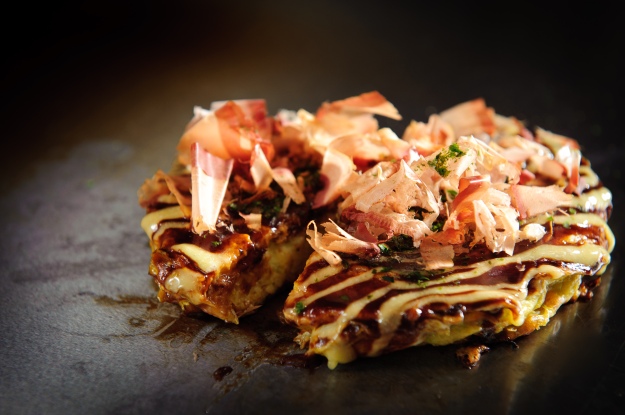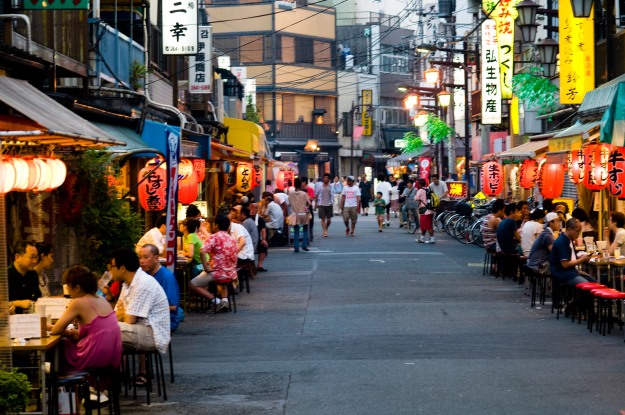When I first came to Japan, I lived in a Tokyo shared house with a small kitchen which made cooking difficult. Most of my meals were either eaten out or bought already made at the local grocery store. Japan had a lot of interesting foods, and I wanted to try them all. Not being able yet to read Japanese, I one day bought what looked like seared tuna. The fish, which was in fact katsuo, was served with green onions and tasted quite fishy. In order to avoid this mistake, I made a point to tell tuna and katsuo apart from that day on. Years later, on a visit to Kochi, my friends reintroduced me to katsuo tataki. I tried it with some reticence but to my surprise it was delicious. Why was Kochi’s katsuo so delicious when Tokyo’s was not?
Know your okonomiyaki

The elusive okonomiyaki (photo by luke chan)
Although one might think it’s suited to the Western palate, okonomiyaki, a dish emblematic of the Osaka region, has never gained the same popularity abroad as ramen. Okonomiyaki is popular in Japan in every sense of the term and its various iterations can be found just about everywhere in Japan. Okonomiyaki which translates as “grill it the way you like it”, seems more a reflection of Western individualism than of Japanese homogeneity. Unsurprisingly, its history, preparation and regional style are far from being clearly defined. Where does it come from? How do you make the dish? What are the different types of local variations?
Surviving a night of drinking in Japan

A hard day’s night (photo by Kitty)
A commonly used expression in Japanese is futsukayoi, or second day drunk which means having a hangover. Drinking is an important part of the cultural fabric of Japan. It is done to socialize with friends and family, to forge bonds between co-workers, to seal business deals and to determine the strengths and weaknesses of competitors. Some Japanese love to drink, others might enjoy the occasional drink, while others simply cannot tolerate a drop of alcohol. Yet, there comes a time when all need to partake in this traditional aspect of Japanese life. In fact, people who choose not to drink at all may be looked down upon with mild suspicion. Drinking might be be felt as a social obligation but is also one of the rare moments when these same social rules can be broken.
Snacking and Drinking on the go in Japan
Everyone will tell you, it is rude to eat while walking in Japan. However, it does not mean that the frantic pace of Japanese life slows down during meal times. From experience, Japanese people, salary men in particular, tend to eat very fast. Moreover, snacking throughout the day instead of observing formal meals is quite common in Japan. During the Edo period, street food, chief among them sushi stalls, occupied a large place in growing cities landscape. This tradition is still alive in Japan’s largest cities where people often seek a quick bite during the few minutes of respite they have from the day’s work. Continue reading
What in the world is shochu?
When it comes to Japanese alcohol, there is a lot of confusion about the use of the term sake. Sake in Japanese is a generic term that designates alcohol and does not refer to Japanese rice wine in particular. In Japan, rice wine is called nihonshu which means Japanese alcohol. Japan also traditionally distills alcohol from various fermented starches in ways similar to the one used to make vodka. The product of this distillation is called shochu (lit. burned alcohol) and it has, in the last few years, taken a growing place in Japan’s drinking habits.
What food to enjoy while travelling in Japan

Quick sit down shops called yatai (photo by Justin C.)
Travel has historically been difficult in Japan. In medieval times, one had to request a special travel permit from the governing authorities to be able to travel. Although travel was limited, snack shops for hungry travelers was an unmistakable part of the premodern landscape. Today this tradition endures. Japanese people can travel freely, yet they most often take very little time off work. In order to make the best out of a short vacation, Japanese tourists will take many pictures of their trip and purchase local food that can be eaten on the spot or at a later time. In this way, tourism and food are inextricably tied to each other in Japanese culture. While travelling in Japan, it is worthwhile to try to discover the different regional foods available.
5 unique Japanese ways to eat eggs

A simple treat (photo by Robyn Lee).
Japan loves eggs and has developed unique ways of eating them. Eggs are so pervasive in most people fridge that we pay them little notice. They have become part of the background, an almost boring necessity. In the digital age, there is no limit to what people might come up with like scrambling eggs in their shell . in Japan, due to Buddhist beliefs that proscribed the killing of animals, both meat and eggs became a staple relatively late in Japan. This singular historic and cultural context has informed the way eggs are prepared in Japan. The place that eggs occupy in Japanese cuisine is quite different than in Western cooking. Rather than being a binder that add richness to a confection, it is most often used as a main ingredient. Japanese breeds of hen and a diet rich in carotene also result in a very different egg with a thick shell and an intense orange yolk.



